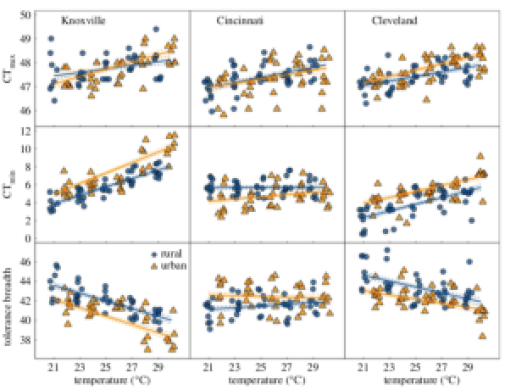In their recent contribution to the special issue on urban evolution in Proceedings B, Sarah Diamond and team share their exciting results on detecting parallel and non-parallel physiological responses to the urban heat island in acorn ants (paper here). This is the first of several posts to come on the recent special issue on urban evolution in Proceedings B.

It is common knowledge now that cities tend to be significantly warmer than nearby natural environments, a phenomenon referred to as the “urban heat island effect.” This creates a selective pressure on urban animals to be able to function and maintain high fitness at elevated temperatures. Since cities are consistently warmer than nearby natural areas, this also allows researchers to ask whether populations of the same species adapt in similar ways to these higher temperatures, or in other words, if adaptive responses are parallel.
Diamond and co-authors investigated this question by studying urban and rural populations of the aptly named acorn ant (Temnothorax curvispinosus), which create colonies inside of acorns. They reared acorn ant colonies from three different cities (Cleveland Ohio, Cincinnati Ohio, and Knoxville Tennessee) and nearby natural areas (that were up to 4.5℃ cooler!) under common garden conditions at five different temperature treatments. They then examined heat and cold tolerance in the offspring by testing critical thermal minimum and maximum (the extreme temperatures at which motor function ceases).
The role of plasticity in thermal adaptation has been widely debated for a number of organisms. Diamond et al. add to the evidence that plasticity does indeed play a role in thermal adaptation as they found thermal tolerance increased with increasing rearing temperature regardless if they were from urban or rural source populations. However, there were population-level differences in urban and rural thermal tolerance: in Cleveland urban ants consistently tolerated higher temperatures; in Knoxville only the ants reared at high temperatures differed between urban and rural populations, with no urban-rural difference at low rearing temperatures; and in Cincinnati urban and rural ants did not differ in their thermal tolerance at all. Thus local adaptation and plasticity both play an important role in determining adaptive thermal responses, and responses are not parallel between cities.

Similar patterns were observed for cold tolerance as well. As rearing temperature increased, the ability of ants to tolerate cold temperatures disappeared. Moreover, in general urban ants were not able to tolerate as cold of temperatures as rural ants (i.e., they had higher thermal minimums), although the Cincinnati populations again diverged with an inconsistent pattern. The loss of cold tolerance in urban populations is somewhat puzzling. It is clear why increased thermal tolerance would be warranted in an urban environment, but why the loss of cold tolerance? One possibility Diamond et al. propose is that a trade-off exists in cold and heat tolerance, which they explore further in their supplementary materials. Another possibility is that thermal breadth, and not necessarily the upper or lower bounds, is the target of selection. In fact, in the Cleveland and Knoxville populations, they found that urban ants had narrower thermal breadth, meaning urban ants simply tolerate a smaller range of temperatures.
Finally, Diamond et al. took their results a step further by directly connecting this thermal performance with fitness consequences. Under warmer temperatures urban populations produced more offspring while rural populations produced fewer.
Together, these data suggest that urban ants experience natural selection for shifted thermal tolerance, and that these physiological shifts are likely adaptive. Their findings shed light on parallel evolution in urban organisms and also on the role of plasticity and local adaptation in thermal adaptation.
Check out the full manuscript:
Evolution of thermal tolerance and its fitness consequences: parallel and non-parallel responses to urban heat islands across three cities
Sarah E. Diamond, Lacy D. Chick, Abe Perez, Stephanie A. Strickler, Ryan A. Martin
DOI: 10.1098/rspb.2018.0036
- New Lit Alert: Urban environment determines population genetics in the green toad, Bufotes viridis - September 11, 2023
- Contribute to the New York Canid Project! - July 21, 2023
- Parallel Urban Adaptation from Phenotype to Genotype in Anolis Lizards - January 19, 2023
